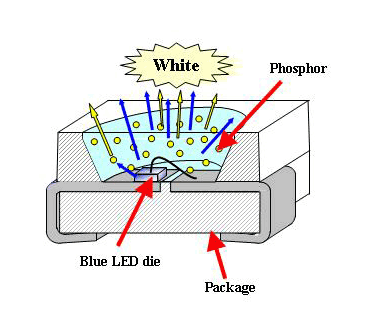制造白光LED的新方法
制造白光LED的新方法
 Light from a blue light-emitting diode is converted into yellow light using phosphors. The resulting white light is produced quite efficiently.
Light from a blue light-emitting diode is converted into yellow light using phosphors. The resulting white light is produced quite efficiently.
日本科学家利用新的萤光剂可以让LED发出接近日光的光谱。
发光二极体可以很有效的将电能转变成光。目前的技术可以很有效的制造出红光、绿光及蓝光的二极体。不过要让发光二极体来取代传统灯泡,那就必须让二极体能够发出像日光般的白光。
一般日光可以经由适当的混合红绿蓝三种颜色的色光来达到。所以科学家有试着利用混合红光绿光及蓝光二极体来发出白光。但是这个方法的问题是成本太高。所以科学家发明另外一种方法,就是在蓝光二极体中加入萤光剂来吸收蓝光并发出黄光。日本的National Institute for Materials Science及夏普公司利用Li–alpha-SiAlON:Eu2+这个萤光剂,可以把460nm的蓝光转换成573-577nm的黄光。他们得到的二极体每瓦的亮度为55流明,比市面上相同色度的发光二极体亮度高了一倍
A new LED design employs a handy combination of light and phosphors to produce light whose color spectrum is not so different from that of sunlight.
Light emitting diodes (LEDs) convert electricity into light very efficiently, and are increasingly the preferred design for niche applications like traffic and automobile brake lights. To really make an impression in the lighting world, however, a device must be able to produce room light. And to do this one needs a softer, whiter, more color balanced illumination.
The advent of blue-light LEDs, used in conjunction with red and green LEDs, helped a lot. But producing LED light efficiently at blue, red, and yellow wavelengths is still relatively expensive, and an alternative approach is to use phosphors to artificially achieve the desired balance, by turning blue into yellow light. Scientists at the National Institute for Materials Science and at the Sharp Corporation, in Japan, have now achieved a highly efficient, tunable white light with an improved yellow-producing phosphor . Their light yield is 55 lumens per watt, about twice as bright as commercially available products operating in the same degree of whiteness.